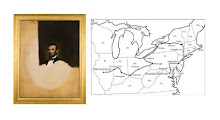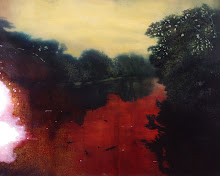Monday, August 9, 2010
Leaving Milford this morning to a cool breeze was a great welcome! The Delaware River was still as glass and reflected the shoreline in perfect symmetry. Not too far from my location Washington crossed this river and signs remind me of the mileage to Valley Forge. A different century for my project and I have to keep focused on my mission as I could easily spend time at all of these sites. Heading south along the New Jersey side of the river, I am riding on a road that looks cut out of rock on the east side. Signs remind me to watch for falling rock and I see brick size debris that would not be a welcome event for bicycle or car. The area feels remote in the early morning and I have to remind myself I am not far from Trenton and New York city. These spaces defy my previously conceived notions of what this area of the country should look like. Stone houses from the 18th century hug the sides of the rock walls and they seem rather unassuming. These are not fancy rehabs or historical registry houses but they appear to be ordinary residences that were perhaps passed down to family members. The towns that pop up by the river crossings all have a bridge street and the roadway narrows to suggest their original design for carts and horses. I eventually cross into Pennsylvania on the west side of the river and come up on stone ruins of an old barn. This whole area has remnants from previous centuries and all of this seems quite foreign to a midwesterner.
The approach into Philadelphia is very easy. This is a bicycle friendly city,-even in the downtown area. Bike paths lead into the city proper and bike lanes traverse the the heart of the downtown streets. William Penn's 17th century design for the Center Square creates a dramatic view. The European roots of his thinking are obvious as I ride around a huge circle by the art museum to traverse the route. The 'Second Empire' style of architectural design for City Hall commands the center space and though it was completed in the early 20th century, it still speaks of history. As I move towards Independence Hall, the several block area becomes part of the National Park Service grounds. These are highly guarded spaces of national importance. Armed guards are outside the site where Lincoln stood by the Hall as well as across the street by the Liberty Bell. On February 22, Washington's birthday, Lincoln responded to death threats on his life by raising an American flag at Independence Hall. His gesture was intended to demonstrate that the Union and the principles that it was founded upon, would be preserved. Having to go through security checks and not being allowed to bring my bicycle and equipment through, I thought that I would miss getting close to this site. The guards brought over the head ranger and I explained my project of retracing the inaugural train route. I also showed him my gallery card of the Lincoln portrait I painted for the Abraham Lincoln Presidental Library and Museum in Springfield, Illinois. He was generous in his understanding and gave me a special escourt to the Lincoln site so I could photograph the space. I wish to thank him and the National Park Service for their generosity! Across the street on the east side of Independence Hall is ironically, the Gilbert Stuart house. Having painted Lincoln in the style of Stuart's half finished Washington portrait and showing my gallery card of the image, I couldn't help but think that the turn of events today was influenced by a collaboration of Mr Lincoln and Mr. Stuart.
The approach into Philadelphia is very easy. This is a bicycle friendly city,-even in the downtown area. Bike paths lead into the city proper and bike lanes traverse the the heart of the downtown streets. William Penn's 17th century design for the Center Square creates a dramatic view. The European roots of his thinking are obvious as I ride around a huge circle by the art museum to traverse the route. The 'Second Empire' style of architectural design for City Hall commands the center space and though it was completed in the early 20th century, it still speaks of history. As I move towards Independence Hall, the several block area becomes part of the National Park Service grounds. These are highly guarded spaces of national importance. Armed guards are outside the site where Lincoln stood by the Hall as well as across the street by the Liberty Bell. On February 22, Washington's birthday, Lincoln responded to death threats on his life by raising an American flag at Independence Hall. His gesture was intended to demonstrate that the Union and the principles that it was founded upon, would be preserved. Having to go through security checks and not being allowed to bring my bicycle and equipment through, I thought that I would miss getting close to this site. The guards brought over the head ranger and I explained my project of retracing the inaugural train route. I also showed him my gallery card of the Lincoln portrait I painted for the Abraham Lincoln Presidental Library and Museum in Springfield, Illinois. He was generous in his understanding and gave me a special escourt to the Lincoln site so I could photograph the space. I wish to thank him and the National Park Service for their generosity! Across the street on the east side of Independence Hall is ironically, the Gilbert Stuart house. Having painted Lincoln in the style of Stuart's half finished Washington portrait and showing my gallery card of the image, I couldn't help but think that the turn of events today was influenced by a collaboration of Mr Lincoln and Mr. Stuart.
Subscribe to:
Post Comments (Atom)






Hi Prof. Pollack!
ReplyDeleteSounds like you are having an amazing adventure! The pictures are absolutely gorgeous- I'm excited to see what is next.
What a great journey and a great cause!